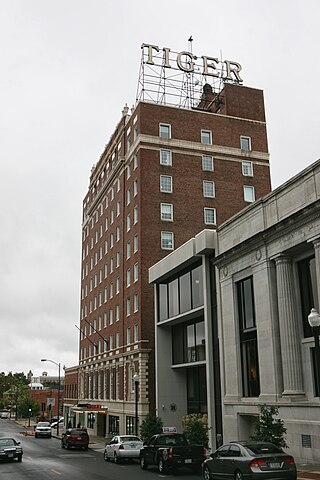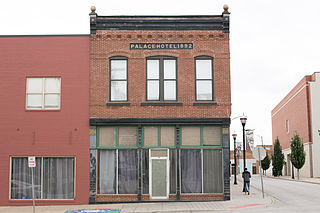
The Brown Palace Hotel, now The Brown Palace Hotel and Spa, Autograph Collection, is a historic hotel in Denver, Colorado, United States. It is listed on the National Register of Historic Places and is the second-longest operating hotel in Denver. It is one of the first atrium-style hotels ever built. It is now operated by HEI Hotels and Resorts, and joined Marriott's Autograph Collection Hotels in 2012. The hotel is located at 321 17th Street between 17th Street, Broadway and Tremont Place in downtown Denver behind the Republic Plaza. The main entrance door is on Tremont Place.

St. Louis Union Station is a National Historic Landmark and former train station in St. Louis, Missouri, United States. At its 1894 opening, the station was the largest in the world that had tracks and passenger service areas all on one level. Traffic peaked at 100,000 people a day in the 1940s. The last Amtrak passenger train left the station in 1978.

The Patee House, also known as Patee House Museum, was completed in 1858 as a 140-room luxury hotel at 12th Street and Penn in St. Joseph, Missouri. It was one of the best-known hotels west of the Mississippi River.
Patee Town Historic District is a national historic district located at St. Joseph, Missouri. The district encompasses 71 contributing buildings and 1 contributing site in the Patee Town section of St. Joseph. It developed between about 1858 and 1939, and includes representative examples of Greek Revival and Italianate style architecture. Located in the district are the separately listed Patee House, a hotel that is a U.S. National Historic Landmark, and Jesse James House. Other notable buildings include the Morey Piro House (1910), Charles E. Herycele House (1903), R. L. McDonald Manufacturing Co. Warehouse (1899), Mrs. Pemetia Cornish Duplex, Fred Wenz Store Building (1903), Fire Station #5 (1939), German Salems Church, and Matthew Ziebold House (1895).

The Missouri Theatre, is a concert and entertainment venue in downtown Columbia, Missouri, occupying most of a city block between 9th street between Locust and Elm Streets. It was designed after the Opéra Garnier by the Boller Brothers, built in 1928, and is on the National Register of Historic Places. It is Columbia's only surviving pre-Depression movie palace and vaudeville stage. In 2011, the University of Missouri began a three-year lease of the facility. The Missouri Theatre is the resident home of the Missouri Symphony Orchestra, and is also frequently used by University of Missouri and civic groups. As of July 1, 2014, The University of Missouri took over ownership of the Missouri Theatre. It is one of the main performance venues for the University of Missouri School of Music.

The Tiger Hotel is a 4-diamond hotel in Columbia, Missouri. Built in 1928, it was converted to a retirement home and banquet center, before being restored and converted back to a boutique hotel in 2012. It was listed on the National Register of Historic Places in 1980.

Downtown Columbia is the central business, government, and social core of Columbia, Missouri and the Columbia Metropolitan Area. Three colleges — the University of Missouri, Stephens College, and Columbia College — all border the area. Downtown Columbia is an area of approximately one square mile surrounded by the University of Missouri on the south, Stephens College to the east, and Columbia College on the north. The area serves as Columbia's financial and business district and is the topic of a large initiative to draw tourism, which includes plans to capitalize on the area's historic architecture and Bohemian characteristics. The downtown skyline is relatively low and is dominated by the 10-story Tiger Hotel, built in 1928, and the 15-story Paquin Tower.

John Lawrence Mauran, FAIA (1866–1933) was an American architect responsible for many downtown landmarks in St. Louis, Missouri. He was also active in Wisconsin and Texas.
Roaring River State Park is a public recreation area covering of 4,294 acres (1,738 ha) eight miles (13 km) south of Cassville in Barry County, Missouri. The state park offers trout fishing on the Roaring River, hiking on seven different trails, and the seasonally open Ozark Chinquapin Nature Center.
Preston J. Bradshaw (1884–1952) was one of the most eminent architects of St. Louis, Missouri, during the 1920s. Among his numerous commissions as an architect, he is best known for designing hotels and automobile dealerships in the region. Like many hotel architects of his time, he eventually moved into the actual operation of hotels, becoming owner and operator of the Coronado Hotel in St. Louis.

The Palace Clothing Company Building in Kansas City, Missouri is a building constructed in 1924. It was listed on the National Register of Historic Places in 1985.
This is a list of properties and historic districts within the Downtown St. Louis and Downtown West, St. Louis areas of the city of St. Louis, Missouri that are listed on the National Register of Historic Places. The downtown area is defined by Cole Street to the north, the river front to the east, Chouteau Avenue to the south, and Jefferson Avenue to the west. Tucker Avenue divides Downtown to the east from Downtown West to the west.

The Courtyard St. Louis Downtown/Convention Center is a historic hotel in downtown St. Louis, Missouri.

Frank M. Howe was an architect in Kansas City, Missouri, and Boston, Massachusetts. He was a partner with Henry Van Brunt in the prominent firm of Van Brunt and Howe. He later partnered with Henry F. Hoit as Howe, Hoit & Cutler.

Palace Hotel, also known as Hudson School, Hudson Community Center, Brown's Chapel, Methodist Episcopal Church, and Hudson Methodist Church, is a historic one-room school building located near Appleton City, Bates County, Missouri. It was built in 1891, and originally housed a Methodist church. It was purchased and reconfigured for use as a school in 1911. It is a one-story, frame building with a cross-gable roof. It measures 45 feet, 6 inches, by 38 feet, 6 inches. It was last used as a schoolhouse in 1952.

Papinville Marais des Cygnes River Bridge, is a historic Pinned Pratt through truss located at Papinville, Bates County, Missouri. It was built in 1884 by the Kansas City Bridge and Iron Co. and spans the Marais des Cygnes River. It is a three span bridge with a central Pratt truss measuring 116 feet and two connected Warren-pony truss spans. It rests on stone abutments with concrete and steel piers and it measures a total of 234 feet long.
West Walnut Street Commercial Historic District is a national historic district located in Springfield, Missouri, United States. The district encompasses 14 contributing buildings in a commercial section of Springfield. The district developed between about 1888 and 1951, and includes representative examples of Italianate commercial architecture. Notable buildings include the Diffenderffer Building (1906), the Koenigsbruk and Boehmer Building, and the Grand Hotel / Springfield Seed Co. Building.

Palace Hotel, also known as the Eldredge Block, Excelsior Steam Laundry, Baltimore Hotel, Gardner Hotel, and Massey Hotel, is a historic hotel building located at Springfield, Greene County, Missouri. It was built about 1892, and is a two-story, Italianate influenced brick commercial building. It has cast iron columns on the first floor storefront, a flat roof, and flat parapet. It originally housed a laundry, then converted to a hotel in 1908. It continued as a hotel until 1946.

Courthouse Square Historic District is a national historic district located at Chillicothe, Livingston County, Missouri. The district encompasses 24 contributing buildings in the central business district and surrounding residential area of Chillicothe. It developed between about 1877 and 1950, and includes representative examples of Late Victorian and Beaux Arts style architecture. Notable buildings include the Livingston County Courthouse (1914), Wallbrunn Building, First National Bank Building #2 (1906), Peoples Trust Building, Nick J. Rensch Building, Davis/Milbank Building, Leeper Hotel, Chillicothe City Hall (1926), First National Bank Building #1 (1887), and Sipple Clothing Co/Broyles Land Co Building.


















